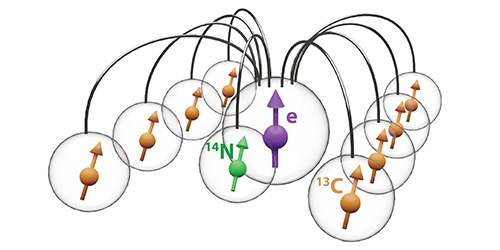Diamond Qubits Take the Stage
In the global race to build a quantum computer, it’s still unclear what material will make the best qubit. Companies have bet on a variety of architectures based on trapped ions, neutral atoms, superconducting circuits, and more. Now, Tim Taminiau of Delft University of Technology, Netherlands, and colleagues have demonstrated that they can manipulate magnetic spins inside diamond into the robust quantum states necessary for quantum computing. In their experiment, they entangle all possible pairs of a ten-qubit system and produce states in which seven different qubits are entangled simultaneously. They also show that individual qubits can retain quantum coherence for up to 75 s—a record for solid-state systems.
The team’s multiqubit system is based on a nitrogen-vacancy (NV) center in diamond—a molecule-like impurity consisting of a nitrogen atom and an atom gap bound together in the place of two carbon atoms. The NV center’s electron spin constitutes the central qubit, while the nuclear spins of the nitrogen and surrounding carbon atoms form the other nine qubits. Because the electron spin responds optically, its quantum state can be programmed and read out quickly using a laser. Consequently, the researchers use the electron spin of the NV center as a bus, programming it first and then coupling it to a nuclear spin through a magnetic interaction. The nuclear spin, which does not respond optically, exhibits longer coherence times than the electron spin—up to 75 s—making it better suited to quantum memory and processing. The researchers plan to scale up this system by joining multiple ten-qubit modules.
This research is published in Physical Review X.
–Sophia Chen
Sophia Chen is a freelance science writer based in Tucson, Arizona.





